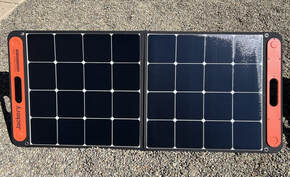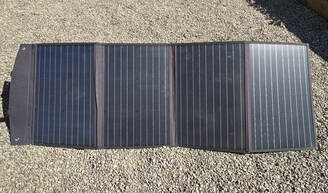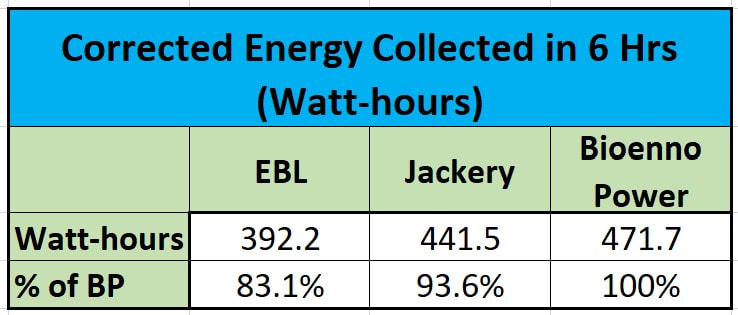 Jackery Solar Saga 100, EBL Apollo 100 and Bioenno Power 100W Solar Panels Jackery Solar Saga 100, EBL Apollo 100 and Bioenno Power 100W Solar Panels I have previously reported on my results testing several different portable power stations from Jackery, EBL and Bluetti along with LIFePO4 batteries from Li Time (formerly Ampere Time), Bioenno Power and Battleborn to power my astronomy rig out in the field. Typically we travel to distant dark sites for multiple nights under the stars and most likely will need some way to recharge a power station or battery during the day. Portable solar panels are a great way to do this when AC power is not available. So in this blog I will review three 100W portable solar panels that I have been using over the last few years. While the panels were sent to me by their suppliers at no cost to me I am under no obligation to provide a positive review and/or avoid negative comments if they are warranted. None of the suppliers has seen this review before it was posted. So here we go. The three solar panels are the Jackery Solar Saga 100, the EBL Solar Apollo 100 and a 100W panel from Bioenno Power. Each is designed for a maximum of 100W of output power, but anyone already familiar with solar panels know that the 100W specification is only achieved under ideal laboratory conditions with a well controlled and uniform light intensity at the optimum angle and at room temperature. In real world conditions, expect to get ~70 to 90% of the specified maximum rating out of any solar panel. All 3 of the panels in this review use monocyrstalline silicon photo voltaic chips which are the most efficient solar panels on the market with an efficiency of 24%.  Jackery Solar Saga 100 The Jackery Solar Saga 100 is highly rated but is one of the more expensive panels at $269 as of this blog. The Jackery has an output voltage of 18V at 5.55A which works out to 99.9W. The panel is fairly large with an unfolded dimension of 48" x 21". When folded it reduces to 24" x 21" and 2" thick which makes it fairly easy to pack away for travel. It has convenient built in carrying handles and magnets to help keep the two halves together when closed. Jackery claims that the panel weighs only 5.5lbs but I measured it to actually be 9lbs, which is considerably more but not difficult to carry around. A big plus of the Jackery compared to the other panels is the two large, 6.25" wide, kickstands which make it easy to set up and keep both halves of the panel at the same angle to the sun. The panel is coated with a plastic material to make it more durable and easier to clean and is splash resistant but not waterproof. I found the overall build quality to be quite good and the panels (I have 2 of them) have stood up quite well to occasional use over the last 2+ years. The electrical connection is inside a zippered case and includes a single 10ft long 16AWG cable with an 8MM male plug designed to be plug compatible with Jackery's portable power stations. If you have another brand of power station which does not use the 8mm connection you can get an adapter to connect the Jackery panel to it. I like the fact that they provide a long cable which allows flexibility in positioning he power station or battery being charged. It is best to keep the power station or battery from direct sun exposure and I typically place it behind the panel. I also like the fact that the input cable is strain relieved at the point that it connects to the panel. There are two USB ports ( 5V/3A USBC 5V/2.4A USBA) at the strain relief which allow direct charging of USB devices by the panel such as your phone, laptop, tablet, camera, etc. The Jackery solar panel comes with a 2 year warranty and technical support is available in Fremont, California so you do not have to email China for help. I will note that one of the 2 Jackery panels sent to me did fail after about 1 year of use for no apparent reason and was promptly replaced with a new panel.  EBL Solar Apollo While EBL is not as well known of a brand in the power station and solar panel business, it has been around since the 90s as a manufacturer of alkaline, NiCd and other types of batteries and chargers. A major appeal of the EBL Solar Apollo 100 is that it is one of the least expensive 100W panels at $149 which is almost half the price of the Jackery. The output voltage of the EBL panel is 20V at 5A which works out to 100W. The EBL is about 23% larger than the Jackery when fully open with an unfolded dimension of 46' x 26.75". It is only slightly larger than the Jackery when folded with a dimension of 26.75 x 23 but that still makes it less convenient to pack for travel compared to the Jackery. It also has convenient built in carrying handles and magnets to help keep the two halves together when closed. The EBL panel weighs 9.5lbs. I wish EBL had made the two kickstands wider like the Jackery as theirs are only 4.25" wide which makes it a little bit harder to support given the larger overall dimensions of the panel. This panel is also coated with a plastic material to make it more durable and easier to clean and is splash resistant but not waterproof. Just like the Jackery the EBL has a zippered pouch which houses the output cables connected to the panel. However, the EBL panel uses a pair of 3ft cables with MC4 connectors on the ends. I found the short cables to be stiff and therefore difficult to manipulate. But they do supply two additional flexible adapter cables, one which converts from the MC4 connectors to a Power Pole connector and the other to a 5.5mm x 2.1mm connector. Plus they include 5.5mm x 2.1mm to 8mm, 5.5mm x 2.1mm to 5.5mm x 2.5mm, and 5.5mm x 2.1mm to 3.5mm x 1.5mm adapters so that the Apollo panel can be connected to pretty much any brand of portable power station. Unlike the Jackery, the Solar Apollo panel does not have a USB charging port. But much more importantly it does not have a rigid strain relief where the cable connects internally to the panel like the Jackery. Instead there is a simple loop which was not enough to prevent one of the cables on the panel from partially coming out of its internal connection exposing a bare lead. The panel comes with a 1 year warranty and technical support is available only through China.  Bioenno Power The Bioenno Power solar panel is designed very differently from the other two panels. It is a quad -fold panel which means that it folds down to a much smaller package measuring 20.5" x 14.5" which makes it easier than either of the other two panels to pack in a smaller space. Unfolder it is the longest of the panels at 57" x 20.5". I found the two 2" wide kickstands totally inadequate to set up the panel so that all four segments are aligned in the same plane. This would be much better if that had 3 or 4 kickstands at least 3" wide. It also has a convenient carrying handle and clips to hold the panel shut. The Bioenno panel weights slightly more than the other two at 10lbs. This panel is priced between the other two at $210 and it has an output voltage of 18V with 5.56A. Just like the other two panels the cable sits inside a zippered compartment. Unfortunately, the cable is even shorter than the one provided by EBL which means that you will definitely need to buy an extension cable to have any practical chance to connect the panel to a power station. But, since the Bioenno Power uses a non-standard 50A Anderson Power Pole connector you would certainly need an adapter cable anyway. Bioenno Power sells an adapter cable which converts to the much more common 40A Anderson Power Pole connector. Like the EBL the Bioenno Power does not have a USB charging port but does have a solid strain relief like the Jackery .  Charging Tests I performed two different charging tests on each panel. The first test was designed to determine the maximum output power of each panel on a clear sunny day in June with the sun at its peak in the sky for the day. Each panel was supported by a piece of plywood to hold it flat in a plane and tilted in altitude and rotated in zenith relative the the sun until a maxim input reading was obtained on a Jackery 1000 portable power station's input meter. The Bioenno Power produced the highest maximum output of 89W, while the Jackery had a maximum of 83W and the EBL panel produced the lowest power output of 72W. As discussed in the beginning we see clearly that the outputs are not 100W. The Bioenno Power panel outperformed the other two with the outputs of the Jackery at ~93% and the EBL at only ~81% of the Bioenno Power's output.  The next test was a 3 hours cumulative power output test. Here I measured the output power produced over a 3 hour period on a clear sunny day in June starting 1.5 hours before the sun peaked in altitude through 1.5hrs after the peak. Thus the panels were exposed to the maximum solar radiation possible on that day. To measure the output power I used identical in-line DC power meters which measure the power, voltage, current, Ah and Wh produced. I needed something for the solar panels to charge during the tests but I did not have 3 identical power stations which would have made the test very simple. Instead, I used my Jackery 1000 and EBL 1000 portable power stations as the loads with the DC power meters between the panels and the power stations. Since the charging circuits on the two power stations may behave differently I had each panel charge each of the two power stations for half the 3 hour time so as to accommodate any variation in power because of differences in the power stations. So each panel charged each power station for 1.5hrs during the test. Now, 3 panels into 2 power stations does not divide evenly. So, I ran the test in pairs, testing all three combinations of pairs over 3 days with clear skies from 11:30AM until 2:30PM swapping power stations and in-line meters at the midpoint of 1PM. Test Order: Day 1: Jackery Solar Saga vs. EBL Apollo Day 2 EBL vs Bioenno Power Day 3 Jackery vs. Bioenno Power The results are shared in Table 2 below which shows that the Jackery produced 35Wh, or 16%, more energy than the EBL Apollo over the 3 hours on day 1. The Bioenno Power panel produced 32.5Wh, or 18%, more energy on day 2 than the EBL panel. And on day 3 the Bioenno Power Panel produced 9.7Wh, or 6%, more energy than the Jackery solar panel.  Table 2. Solar Correction Factors Table 2. Solar Correction Factors Now, to be fair, even though the measurements were done at the same times on all 3 days, and even though all 3 days were clear sunny days, we cannot be certain that the flux of photons was the same each day. But there is a way to correct for any differences in the amount of solar radiation over the 3 days. We can normalize the numbers to the one of the panels on one of the days, in this case, the Bioenno Power output on Day 2. Since we have each panel tested on 2 days we can take advantage of the readings on the same panel from day to day to correct for differences in solar radiation. If we take the ratio of the Bioenno Power reading on Day 2 to Day 3 we get 121.1 / 117.6 = 1.03, which means that the solar radiation on Day 2 was 3% higher than on Day 3. Next we can scale the EBL measurements from Day 2 and Day 1 to get 101.4 / 94.5 = 1.07 which shows that the solar radiation on Day 2 was 7% higher than on Day 1. Using these Solar Intensity Correction factors we can scale the Day 1 and Day 3 readings to the readings on Day 2 using 1.07 to scale Day 1 and 1.03 to Scale Day 3 as shown in Table 2.  Table 3. Energy Output of each solar panel over 2 days (6hrs) corrected for day to day solar radiance differences Table 3. Energy Output of each solar panel over 2 days (6hrs) corrected for day to day solar radiance differences The result is the corrected Table 3 shown below. This shows that the panels collected a total of 392 to 471 Watt-hours of energy over a 6 hour period of peak solar intensity. The Bioenno Power panel collected the most energy at 471Wh. If the panel had actually output 100W during those 6 hours we would have expected 600Wh of energy. Instead, we got 78.5% of the ideal expectation. Now keep in mind, the panels lay flat on the ground so they we not at the optimum angle to the sun throughout the data collection period. I am certain if I had tilted the panel for its maximum output and adjusted it multiple times over the course of the 6 hour test we would see something in the high 80% range as we saw in the maximum output test above. The Jackey panel produced less energy over the same time at 441.5Wh which is just under 94% of what the Bioenno Power produced. This is very consistent with the maximum output test discussed above. The EBL panel came in significantly behind the other two panels at 392.2Wh which is only 83% of what the Bioenno Power panel produced. This is also in line with the maximum output test. Out of curiosity I measured the area of the solar cells on each panel and found the following: Jackery Solar Cell Area: 820 sq-inches EBL Solar Cell Area: 950 sq-inches Bioenno Power Solar Cell Area: 951 sq-inches I was not surprised to see that the area of the Bioenno Power panel is greater than that of the Jackery. The ratio of the areas is 86% which explains why the Bioenno Power produces more output than the Jackery, although I am surprised that the Jackery puts out 93% of the power of the Bioenno panel given the size differential. What surprises me more is that the EBL panel has the same collection area as the Bioenno Power panel, yet it produces only 83% of the power. While all the panel manufacturers claim efficiencies of 24% we see that the overall efficiency of the Jackery appears to be higher than the other 2. If we divide the output in Table 3 for each panel by the measured solar cell area we get: Jackery : 0.54Wh/sq-inch EBL: 0.41Wh/sq-inch Bioenno: 0.50Wh/sq-inch Summary
The Bioenno Power panel is the clear winner in terms of output and overall compactness of design. Its only detractors are the two small kickstands which are not quite ideal for the length of the unfolded panel and the short cable with the non-standard connector. Although the Jackery produced slightly less output compared to the Bioenno Power panel the design is easier to handle with just two panels instead of four, wide kickstands for excellent support, a long and flexible output cable long and USB charging ports. The output of the EBL panel is quite surprising given the area of the solar cells. While the panel is much less expensive than the other two, both the lower output power and lack of an adequate strain relief on the cable input to the panel makes this panel much less attractive. You can find a video version of this review on my YouTube channel here www.youtube.com/watch?v=0LmzAM98sAQ Amazon links above are affiliate links which can earn a small commission at no cost to you. Using these helps to support this web site. Jackery 100W Solar Panel amzn.to/3rR3wmZ EBL 100W Solar Panel amzn.to/3s1wtMX Bioenno Power 100W Solar Panel www.bioennopower.com/collections/solar-controllers/products/bioenno-power-bsp-100-lite-model-100-watt-foldable-solar-panel
0 Comments
|
Categories
All
Archives
January 2024
|




 RSS Feed
RSS Feed